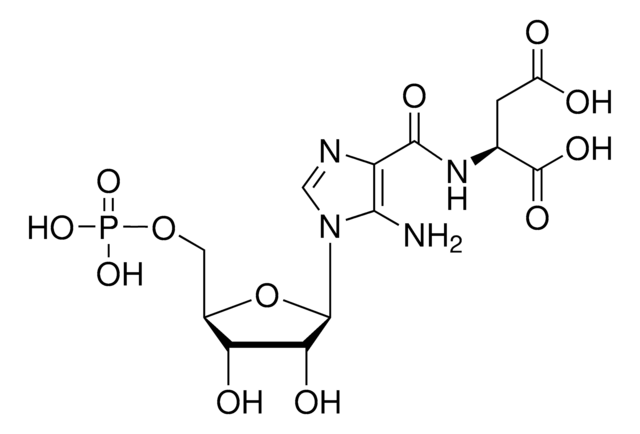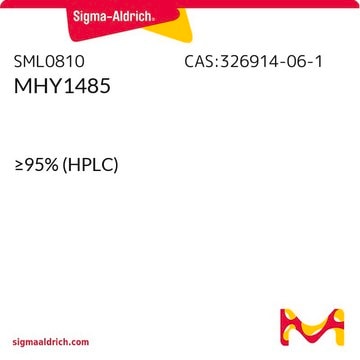A1393
5-Aminoimidazole-4-carboxamide-1-β-D-ribofuranosyl 5′-monophosphate
≥93%
Synonim(y):
AICAR monophosphate, N1-(β-D-5′-Phosphoribofuranosyl)-5-aminoimidazole-4-carboxamide, NSC 283955, NSC 292227, ZMP
About This Item
Polecane produkty
Próba
≥93%
Postać
powder
masa cząsteczkowa
338.21 g/mol
temp. przechowywania
−20°C
ciąg SMILES
O[C@H]1[C@@H](O)[C@H](N2C=NC(C(N)=O)=C2N)O[C@@H]1COP(O)(O)=O
InChI
1S/C9H15N4O8P/c10-7-4(8(11)16)12-2-13(7)9-6(15)5(14)3(21-9)1-20-22(17,18)19/h2-3,5-6,9,14-15H,1,10H2,(H2,11,16)(H2,17,18,19)/t3-,5-,6-,9-/m1/s1
Klucz InChI
NOTGFIUVDGNKRI-UUOKFMHZSA-N
Szukasz podobnych produktów? Odwiedź Przewodnik dotyczący porównywania produktów
Opis ogólny
Zastosowanie
Działania biochem./fizjol.
In humans, 5-Aminoimidazole-4-carboxamide-1-β-D-ribofuranosyl 5′-monophosphate (AICAR) is found to be accumulated in numerous metabolic diseases. It can increase the endurance of sedentary mice. AICAR exhibits antiproliferative effects. It can induce apoptosis of aneuploid cells.
Kod klasy składowania
11 - Combustible Solids
Klasa zagrożenia wodnego (WGK)
WGK 3
Temperatura zapłonu (°F)
Not applicable
Temperatura zapłonu (°C)
Not applicable
Środki ochrony indywidualnej
Eyeshields, Gloves, type N95 (US)
Certyfikaty analizy (CoA)
Poszukaj Certyfikaty analizy (CoA), wpisując numer partii/serii produktów. Numery serii i partii można znaleźć na etykiecie produktu po słowach „seria” lub „partia”.
Masz już ten produkt?
Dokumenty związane z niedawno zakupionymi produktami zostały zamieszczone w Bibliotece dokumentów.
Klienci oglądali również te produkty
Nasz zespół naukowców ma doświadczenie we wszystkich obszarach badań, w tym w naukach przyrodniczych, materiałoznawstwie, syntezie chemicznej, chromatografii, analityce i wielu innych dziedzinach.
Skontaktuj się z zespołem ds. pomocy technicznej
















